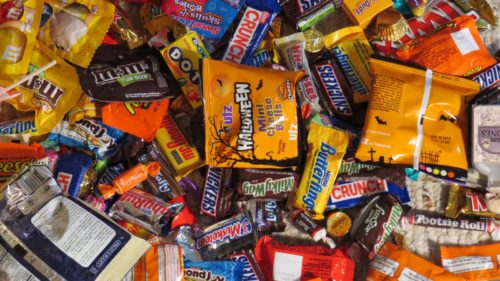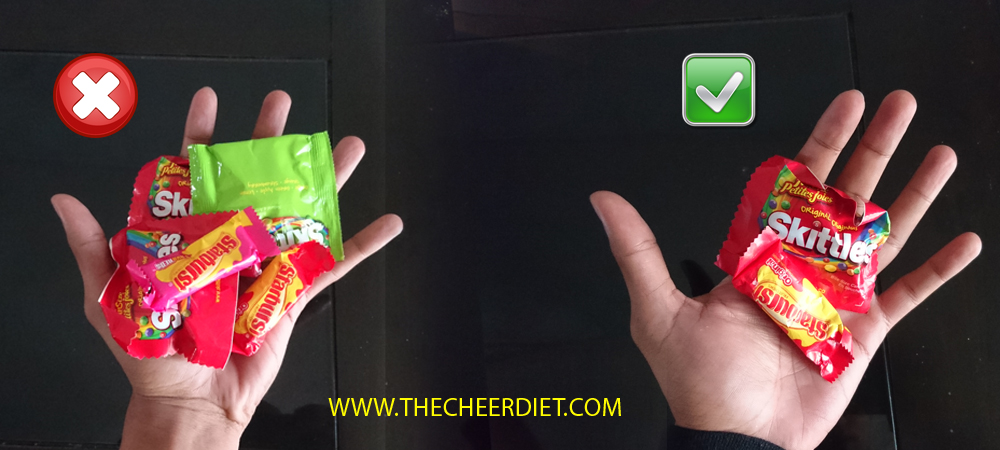 As we approach the scariest time of the year, I get questions like the one below from concerned parents all the time.
As we approach the scariest time of the year, I get questions like the one below from concerned parents all the time.
“Hi Coach Sahil,
What should I do about all the halloween candy that my kids gather after trick or treating? As a parent of an athlete, should I think long term and throw it away? Or should I let them have a few pieces every now and then?
On one hand, I don’t want to rob them of the joy of dressing up and going out with their friends. But all that sugar just cannot be good for them, especially when they have important practices to attend the next day. I’d love to know if you have a solution.
I look forward to your reply”
– Susan
First of all, you should know that I’m totally with Susan on this – there is no need to rob kids (or even young adults) of the joy of going trick or treating.
I know I’ve had some great trick or treating experiences in my past, and wouldn’t trade those childhood memories for all the money in the world.
But of course, as we all know, an overdose of sugar is not the optimal diet for young athletes.
Luckily, this is one of those situations where we can “turn lemons into lemonade.”
I’m going to lay out a proven game plan that will let your kids to have their Halloween candy, save you some money on your grocery bill, and help them perform better at cheer (or whatever happens to be their sport of choice).
So let’s dive in.
Step 1: Eat A Proper Dinner Before Trick or Treating
![]()
 Empty bellies + a bag full of treats + walking around for hours equals kids that end up having sugar for dinner (without you even knowing).
Empty bellies + a bag full of treats + walking around for hours equals kids that end up having sugar for dinner (without you even knowing).
I remember going out trick or treating with my friends and getting desperately hungry halfway through our romp. So naturally, the only thing we could do is dig into our bags and stuff ourselves with as much candy as we could.
This never ended well. So what you want to do is make sure your child has a protein rich and fiber rich dinner before you head out.
Make it a rule; no dinner, no trick or treating.
What’s more, candy companies have designed their packaging with some real psychological science behind it.
All those colors and shapes are no accident! They’ve been meticulously tested to induce hunger, instant cravings and salivation in the mouth. The only way to combat this is to have their bodies send their brain a single that says, “hey, we don’t need any more calories. The tank is full!”
So what should you eat? Well a chicken breast with a bowl of salad that consists of leafy greens and some sliced avocados will keep even a grown man full for hours upon hours.
This will ensure that when you get back home, all they’ll have space for is a piece or two — which is totally warranted for all the walking they did.
Step 2: Separate The Good From The Bad
 This has become common practice with a lot of parents throughout the years, but it still bears repeating.
This has become common practice with a lot of parents throughout the years, but it still bears repeating.
Go through their bag and sort out the quality candy from the crap candy.
If you don’t know the difference, a real simple way is to set aside the name brand stuff from the stuff that’s completely alien to you. Once done, throw out the junk.
As a kid I had no choice in the matter. If mom declared something was garbage, it would get tossed. If I protested, the “good” candy would also get the death sentence.
And sometimes, tears would follow.
Only now I appreciate what she did for me. So don’t let a few pretend tears stop you from doing the right thing (because truthfully, that’s what they are; every child is an Oscar-worthy actor or actress that can tear up on demand).
Step 3: Portion The Candy Into Reasonable Serving Sizes
Generally speaking, when I’m consulting high level athletes or clients on their nutrition plan, a serving is usually the amount of food they can fit in one palm-full.
But because candy is so calorically dense (as in, it packs a huge amount of energy in a small volume of space) the serving size has to be much smaller.
See the picture below for a good example of what I mean.

What you want to do is portion out the candy, and put them into small plastic bags (zip-lock ones work well).
Now remember: you don’t have to be perfect. Portions can vary slightly since candies tend come in a variety of different sizes. If you’re unsure, just play it safe by creating smaller portions.
Once you have your portions sorted out, I’m going to show you how and when you can let your kids enjoy their treats, and have it be useful fuel.
Our Primary Goal: Turn the sugar into usable fuel instead of useless fat!
To ensure this, I’ve come up with 2 optimal timing “windows” in which your kids are allowed to consume their sugary treats. Let’s take a look at each one.
Timing Window #1: One serving, 30 minutes before practice
Because candy is so easily digestible, the sugar hits the blood stream rather quickly. Once that happens, your body only has 3 options:
- Store it as fat
- Use it as fuel
- Get rid of it
As you can imagine (and if the childhood obesity rates are any indication), option #1 ends up dominating. However, if you know they’re headed to practice then you can let their bodies take full advantage of option #2. This extra fuel will help them jump higher, stunt stronger and get through their conditioning without dying.
Oh and don’t forget to force them to consume at least 2 glasses of water. Carbohydrates need water in order to be absorbed efficiently by the body. I wrote an entire article on hydration that I highly recommend you check out.
“the primary goal is to turn Halloween candy into useable fuel, instead of useless fat!” (Tweet This)
Timing Window #2: Intra-Practice
If you know your child’s practice session is going to be 2 hours or longer, it’s perfectly fine to send them on their way with an extra serving of candy they can have mid way through the practice as a “pick me up.”
Side Note: Of course, a more healthy snack alternative is preferred but since this article is about candy, allow me to stick with the theme.
A quick burst of sugar is especially useful for cheerleaders who are in the middle of competition season, and have to perform their routines full-out, multiple times. I don’t know about you, but I’m perfectly fine with my bases having a mini Kit-Kat bar if it means they’ll have the extra energy to keep their flyers from hitting the floor after a 10 foot basket toss!
But once again, be sure to remind them about adequate water intake.
Optional Timing Window #3: Post Practice
If your child’s practice session has gone for longer than 3 hours, the first thing they should do when they get home is have a proper dinner or post-practice meal consisting of quality protein, carbohydrates, and vegetables.
However, a serving of candy as a dessert is just fine because if they work as hard as my girls do, their muscle glycogen (sugar) levels are pretty much depleted.
There is one side note to this rule – if they want to have candy post practice, they cannot have it intra-practice. Regardless of how hard they work, candy intake pre, intra and post practice just doesn’t make any sense.
Some Sweet Closing Thoughts
I hope this article shed some light on how and why candy doesn’t always have to be the “bad guy.”
I personally love my fair share of candy. I mean, it would be pretty hypocritical of me to have my M&M’s while telling my athletes they can’t have any.
If there’s one important take home point that I want you to remember, it’s that we should always try pairing candy with physical activity.
As long as you can help your kids do (and understand) this concept, they’ll be fine. What’s more, kids are more likely to build healthy relationship with sugary treats if they understanding that it’s fuel just as much as it is an indulgence.
Oh and don’t forget, if you’d like recipes for snacks that are not only healthy, but performance-boosting as well, then be sure to check out The Cheer Diet. You can learn more about the book below.
Enjoyed This Article? Then Why Not Go For The Full Experience?
So while your competition is stuffing themselves with fast food and TV Dinners (which result in cramps, low energy and mental fatigue), you can get the edge by knowing which foods reduce muscle soreness, increase concentration and give you endless energy to bring home the gold!
Grab your copy of book today!

– Coach Sahil M.
Certified Gymnastics Coach
Fitness & Nutrition Consultant
Author, The Cheer Diet
Former National Champion
National Deadlift Record
Founder of Addicted To Tumbling

